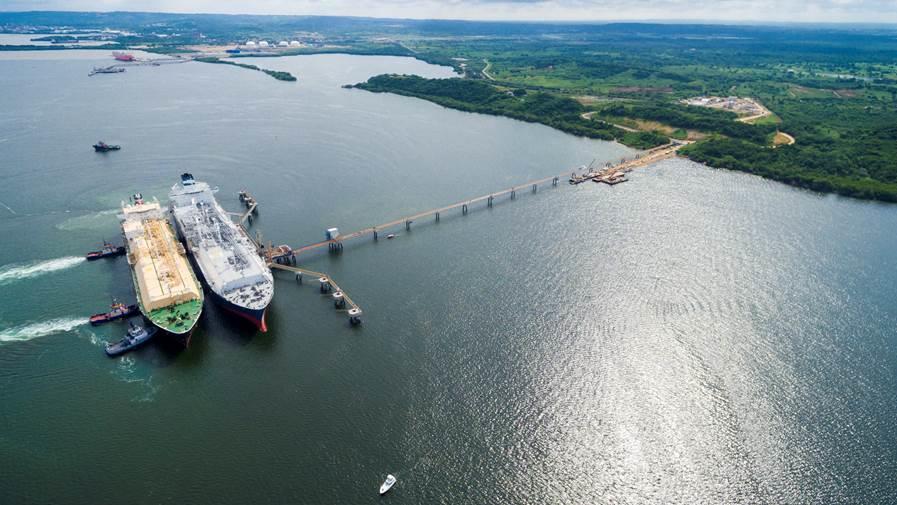
Germany has officially launched construction of an LNG terminal at Wilhelmshaven, while signing up preliminary agreements for four FSRUs.
Federal Minister Robert Habeck and the Lower Saxony Ministers Olaf Lies and Bernd Althusmann oversaw the ceremonial pile driving at the port today.
The German government and RWE have chartered two FSRUs from Höegh LNG, with the aim of starting up as early as next winter.
Uniper signed a letter of intent (LoI) with Dynagas for two FSRUs, again for the federal government. The company will also invest around 65 million euros ($69mn) in the regas terminal, which it will operate.
“An accelerated energy transition is the be-all and end-all for a cheap, independent and secure energy supply,” Habeck said. “We need to triple the pace of expanding renewables on water, on land and on the roof and accelerate the ramp-up of water management. And that can only be achieved together.”
Germany had originally intended to charter three, but scaled this up to four. The country has budgeted 2.94 billion euros ($3.11bn) for the security of supply project.
RWE
Höegh said it had signed binding implementation agreements with the German Federal Ministry for Economic Affairs and Climate Action. The contracts would run for 10 years.
Höegh plans to reach detailed contracts by September or October. “FSRU operations are expected to commence at the end of this year”, the vessel provider said.
RWE will have operational responsibility and will make commercial decisions. The company will work in the interests of the German government, it said.
The two FSRUs will be capable of providing 10-14 billion cubic metres per year of gas to the German market. RWE drew a comparison with a land-based terminal, which it said could provide 8-10 bcm per year.
The German government will be responsible for framework conditions on procuring LNG. The government has ordered four FSRUs, from RWE and Uniper.
One FSRU will be located at Wilhelmshaven, RWE said. The government has said the second vessel would go to Brunsbüttel.
RWE Supply & Trading chairman Andree Stracke said the FSRUs would provide gas direct to the grid. “In this way, the company is supporting the German government in strengthening the security of supply in Germany in the short term and in moving away from a one-sided energy dependency as quickly as possible.
“As early as next year, it will thus be possible to replace part of the Russian gas.”
Höegh has 10 FSRUs in its fleet, of which eight are under contract. As of June this year, the company may have three available: the Höegh Esperanza, Höegh Gannet and Höegh Galleon.
Uniper
Uniper said the first phase at the terminal would be for an FSRU, connecting via the Umschlagsanlage Voslapper Groden (UVG) sea bridge. Niedersachsen Ports (NPorts) will adapt the UVG and connect it to the FSRU.
Open Grid Europe is working on a connection to the national grid, 28 km away. This will also provide a link to the Etzel gas storage.
The second phase of work at the port will provide scope for the import of green gases – particularly ammonia. It will transport green ammonia by rail or crack it on site into hydrogen.
“We are doing our utmost to support the German government in its plan to diversify Germany’s sources of supply for natural gas and, in the long term, also for hydrogen,” said Uniper CEO Klaus-Dieter Maubach.
“With our LNG terminal, we are taking an important step – in close cooperation with the German government – towards the desired energy independence. In doing so, we are relying on our expertise as a global LNG player and gas trader. In the medium and long term, we are developing Wilhelmshaven into the energy hub of the future, with a focus on hydrogen and green gases.”
The company has not made a decision about where to install the FSRUs yet. The German government suggested Stade, Rostock, Hamburg-Moorburg or Eemshaven in the Netherlands.
Hydrogen plans
Wintershall Dea has also set out new plans for Wilhelmshaven today. The company said it planned to develop its BlueHyNow project at the site.
This would produce 200,000 cubic metres per hour of hydrogen – around 5.6 TWh per year. It will use wind power generated in the North Sea.
The company will also use the port to export CO2 to sites offshore Norway and Denmark. Germany has the potential to store 2.9bn tonnes of CO2 offshore, it said The company called for Germany to modernise laws to allow offshore carbon capture and storage (CCS).
“Wilhelmshaven is an ideal location for BlueHyNow and can also be expanded into a logistics collection point for CO2,” said Klaus Langemann, head of Carbon Management & Hydrogen at Wintershall Dea.
“Unavoidable CO2 emissions from all over Germany can be pooled there and shipped from Wilhelmshaven to be stored safely. That would make a significant contribution to decarbonisation in Germany.”
One think tank has estimated Germany will still be emitting 63 million tonnes per year of CO2 in 2045. “CCS is a feasible solution for these emissions,” said Langemann.
